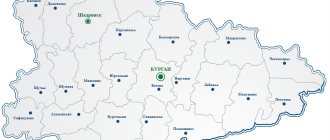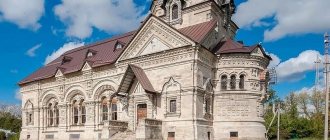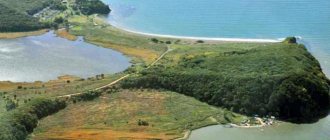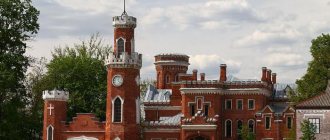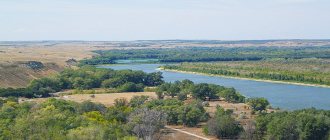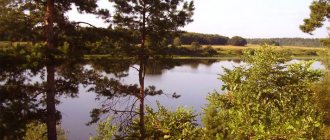Famous for the finest down scarves, the Orenburg region is located in the south of the Eastern European part of Russia. This is one of the largest subjects in the country. Satellite maps of the Orenburg region allow you to get to know it without leaving your home. You will consider borders, cities, rivers and transport routes. You can learn about attractions and find their locations. Maps are a great help for both tourists and residents of the region. The online service is indispensable when travelling.
The region has common borders with Kazakhstan, Bashkiria and Tatarstan. Also, maps of the Orenburg region with diagrams show that it is adjacent to such areas as:
- Samara;
- Saratovskaya;
- Chelyabinskaya.
Most of the land is occupied by arable land. The hydrography of the region is also extensive. There are several large rivers in the region:
- Ural;
- Sakmara;
- Samara;
- Ilek.
One of the largest natural reservoirs is Lake Shalkar-Ega-Kara. Its banks stretch for almost 100 km. Also very popular among local residents and tourists are the salt lakes in Sol-Eletsk, which are indicated on the map of the Orenburg region with its districts. This body of water is so saturated with salts that it allows you to stay afloat and not drown.
The Orenburg region is a large region with a distinctive and ancient history. If you are planning a trip to this land, use the online service with interactive maps. You can quickly find attractions in areas of the Orenburg region on the map, the location of cities and villages, and main roads.
Districts on the map of the Orenburg region
The region includes 35 districts. The largest of them, Orenburg, is located in the center of the region. This is an economically important area; large enterprises are located on its territory, as well as one of the largest gas fields.
In addition, all transport routes pass through the area. The following roads intersect here:
- R-239;
- R-240;
- A-305.
If you are traveling by car, then a detailed road map of the Orenburg region will be very useful on the road and will help you quickly navigate when moving around the region.
The area also contains railway lines that connect the central part of the country with Southeast Asia. A large amount of cargo in this direction passes through the freight station of the Orenburg railway station.
There are 2 airports in the region, which are located in Orenburg (international) and Orsk. The city of Orsk, as the map of the Orenburg region with settlements shows, is located in the southeast of the region and is the 2nd most important city in the region. It has its own railway station and an extensive network of roads.
The smallest districts are located in the north of the region - Abdulinsky and Northern. The population of each of them is slightly more than 20 thousand people. There are no industrial enterprises in these areas; the population is employed in the agricultural sector. Rye, potatoes, legumes, and beets are grown here. There are farms for breeding cows and horses.
Distinctive features and history of the Orenburg region
On this blizzard, unkind evening, When there is snowy darkness along the roads, You, dear, throw an Orenburg down scarf over your shoulders.
The well-known hit by Lyudmila Zykina All of us, Russians, imagine the Orenburg land as a snowy region, where all the women are wrapped in down scarves. For this, Orenburg residents should be grateful to the Soviet singer Lyudmila Zykina, who created such a vivid and rather unlikely image in the minds of millions of people.
In fact, the Orenburg region is a region in the south of the Urals, where it is warmer than in most of the country. In general, this territory became part of Russia back in the 30s of the 18th century, when local Bashkirs and Kazakhs decided that it was easier to be dependent on Russia than to try to somehow exist themselves. In principle, this is a normal strategy; it was followed by the majority of small nations that eventually became part of the Russian Empire.
Composition Good Angel of Peace. Photo by Olga (https://fotki.yandex.ru/users/olga57orb/)
Since then, the lands of the Orenburg region began to be actively populated by settlers from the central regions of the country. Initially, the Orenburg province was of such frightening proportions that its southern border ran along the northern shores of the Aral Sea. Then a whole mess began with the territorial structure here. In 1920, on the site of the Turgai, Ural, Semipalatinsk, Orenburg regions and part of the Transcaspian region, the Kirghiz Autonomous Soviet Socialist Republic was organized, which in 1925 was renamed the Cossack Autonomous Soviet Socialist Republic, and the capital of this autonomy was located in Orenburg.
Next, the party leadership thought and consulted and withdrew the capital from the Cossack Autonomy along with the adjacent territories. The modern Orenburg region became part of the Middle Volga region, which after some time was renamed the Middle Volga region. Five years passed, and the Bolsheviks again decided to change something. This time, the Soviet authorities removed the Orenburg region from the Middle Volga region. It would seem, thank God, a reasonable decision, but no. Less than five years later, the regional center, the city of Orenburg, was renamed Chkalov, in honor of the legendary pilot. The logic here can hardly be traced at all. Chkalov had never even been to Orenburg. The Chkalov region was renamed again to the Orenburg region, 20 years later, by Nikita Sergeevich Khrushchev. Since then, no one else has encroached on the name of the region.
The Orenburg region can be proud not only of stories of renaming and legendary songs, but also of no less legendary fellow countrymen. There is no point in naming all the talented and famous people who were born in the Orenburg region; we will focus on only three: Chernomyrdin, Shatunov, Guzeeva. All of them influenced Russia in different ways, but they left a mark. Guzeeva is currently the idol of all housewives, and can safely create a women’s party from those over 40. They will definitely get into the State Duma. Shatunov, due to his youth, drove millions of Soviet girls crazy, who are now ready to follow Guzeeva to the ends of the earth.
Bridge in Orenburg. Connects Europe and Asia. Photo by Marina (https://fotki.yandex.ru/users/marnat108)
Let’s take a closer look at the figure of Viktor Stepanovich Chernomyrdin. Because he deserves it. For five years, Chernomyrdin headed the Government of the Russian Federation. The period of his work in the highest echelons of Russian power occurred during the most difficult years in the history of the country. Older people will never forget the famous negotiations between Chernomyrdin and Shamil Basayev, which the politician conducted after the terrorist attack in Budennovsk. It was not possible to save everyone, but Chernomyrdin persuaded the terrorist to release most of the hostages. Younger Russians will remember Viktor Stepanovich thanks to the performances of comedians who mercilessly parodied the politician and ridiculed his unique speech and amazing turns of phrase:
“We wanted the best, but it turned out as always.” — No matter what party we make, everything works out for the CPSU. - When my country is in this state, I will do everything, I will say everything! When I know it will help, I won't hold it back. - We! To go to some kind of wishlist, I apologize... There’s nothing to arrange here, I don’t want to, I don’t want to - Well, what should we unite with him? He has a cap, and I’m not wearing anything at all yet. (About Luzhkov.)
Geographical position
By Russian standards, the Orenburg region is not large. Its area is only 123,700 km², which is 3 times the area of the Netherlands, Denmark or Switzerland. In Russia, the Orenburg region ranks only 29th in terms of area. The region's territory is located at the southern tip of the Urals, Trans-Urals and the southeastern part of the East European Plain. The Orenburg region extends 755 km from west to east, and 425 km from north to south. The region has the largest border with Kazakhstan.
Population
According to the latest data, the population of the Orenburg region has already exceeded 2 million people. In total, 2,008,566 people live in the region. The population density will seem ridiculous to the Chinese or Japanese - 16.23 people/km2 (2014). Almost 60% of Orenburg residents are urban residents.
Since 2012, the region's birth rate has exceeded death rates. The average Orenburg family consists of 3.3 people, which suggests that there is a tendency for families to have a second and even a third child. The age composition of the region is such that 17% are pensioners, 67% are the working population, and the remaining 15% are children and youth.
Three quarters of all residents of the region consider themselves Russian; there are communities of Tatars, Ukrainians, Bashkirs, Mordvins and Kazakhs in the region. In percentage terms, Tatars are approximately 8%, Kazakhs - 6%, Ukrainians - 2.5%, Bashkirs - 2.3%. Other nationalities are represented insignificantly.
Figure of a Sarmatian deer. Photo by Marina (https://fotki.yandex.ru/users/marnat108)
You can only partially trust the statistics for the Orenburg region. Small peoples such as the Chuvash or Mordovians are heavily mixed with the Russians, and many, to simplify things, no longer pay attention to their true roots.
Crime
In the 90s, Orenburg was the gateway to Asia. Drugs were supplied through the region to Russia, and this was a feeding ground for bandits. Because of this, the region was regularly shaken by criminal conflicts, which resembled military operations rather than a dialogue between serious people. To this day, for example, the grave of the famous local crime boss Sergei Babnishchev reminds of that time. In the cemetery where the mafioso is buried, an eight-meter crucifix of Christ was erected in his honor. It is curious that a music center was built into the coffin of the crime boss, and at first sad music from underground was heard at the man’s grave. The mafia guarded Babnishchev’s burial site as an honor guard.
The Orenburg region became calm only in the middle of the last decade, when the last authorities retired or simply chose more peaceful ways to resolve conflicts. In recent years, pedophilia has become a resonant criminal topic in the life of Orenburg and its environs. A sect engaged in such debauchery was discovered in the city. Moreover, one of the child molesters was Honored Artist of Russia Grigory Cheblakov. Unfortunately, such scumbags are still detained in the region.
Unemployment rate
In the Orenburg region there is no unemployment rate, there is a “employee” level. If desired, everyone can find something to do here. The region is quite developed, but there is a problem that prevails in most regions of Russia - there is work, but the salary level is not satisfactory. Sellers, service personnel and builders can find a job without any problems. Representatives of other professions need to try or retrain as sellers, service personnel or builders.
Orenburg gas scraper. Photo by Dmitry Zolotarev (https://fotki.yandex.ru/users/dgzolotarev/)
In Orenburg, Orenburggazprom is considered the city-forming enterprise. If you are lucky enough to get a job here, then consider that life is good. In general, in the region the average salary is 22 thousand rubles. You can’t do much with this money, but it’s possible to live.
Property value
You can buy a house in the region inexpensively, but here, as elsewhere in Russia, there are few people who want to live in the village. Young people are trying to go to the regional center, but the situation there is completely different. On average, the price per square meter of housing in Orenburg exceeds 50 thousand rubles. To buy a normal one-room apartment you need to have an amount of no less than two million rubles. Not everyone can save so much money, but a mortgage was invented especially for such people, and a large number of Orenburg residents have already fallen into bondage.
Climate
The climate in the Orenburg region is temperate continental; closer to the western border of the region, a sharply continental climate predominates. Summer in the Orenburg region is hot and dry. Five months of the year are warm, five months are cold, two are moody. In winter, temperatures can drop to −40 °C. The average annual temperature in the region is +5.3 °C, which is quite warm by Russian standards.
Map of the Orenburg region with cities and villages
The region's cities were historically built on mining sites where mills and factories were established. One of the large industrial cities that can be found on a detailed map of the Orenburg region is Novotroitsk. Large deposits of iron ore were found in this place, so combines and factories were immediately formed to process this mineral, and the city quickly acquired the status of an “Orenburg magnet”.
In total, there are 12 cities in the region. The most significant of them, besides the capital of the region, are:
- Orsk;
- Buzluk;
- Novotroitsk;
- Abdulino.
Looking at the map of the Orenburg region with cities and villages, you can also find the main tourist center of the region - Sol-Iletsk. This is a unique place, with salt lakes and healing mud. The resort is located in the south of the region, so the air temperature here during the peak season reaches 38 degrees. The hot, dry climate and salt-saturated air have a beneficial effect on the human body, so in the summer it is always very crowded here.
In small settlements located on the picturesque expanses of rivers, there are a large number of tourist centers. A map of the Orenburg region with villages will help you find any object.
Cities of the Orenburg region
Orenburg is a city where down scarves are made. In total, just over half a million residents live in the regional capital. Basically, the population of Orenburg is increasing due to visitors from villages, but in recent years the birth rate has also been increasing. There are no problems finding work in Orenburg, but real estate is quite expensive.
Orsk is a city with 234 thousand inhabitants. In terms of all indicators, it ranks second in the region, right behind the regional center. Orenburg and Orsk are separated by 286 km, which is a lot. The city has a sufficient number of large industrial enterprises in the field of heavy engineering and petrochemicals. Orsk is not poor, but young people here are bored.
Economy and industry of the Orenburg region
More than 25% of the total population works at industrial enterprises in the region. The following industries are developed here:
- metallurgy;
- petrochemistry;
- food;
- mining
On the territory of the region there is the world's most famous factory of down scarves, which are woven from goat down. All enterprises are reflected on Yandex maps of the Orenburg region. You can also find the location of agricultural complexes. The region is engaged in both crop production and livestock farming. In the southern regions, melons and melons are grown, which tourists from other regions are happy to purchase.
Natural features of the area, rivers and lakes.
If you look at the satellite map of the Orenburg region, you can see that it is located at the junction of Europe and Asia.
There are no high peaks in the Orenburg region - the highest point is the city of Nakas (667.6 m.). The territory is mainly covered with forest-steppes, steppes and forests. Due to the remoteness from the seas and oceans, the climate in the Orenburg region is sharply continental, characterized by low precipitation. The water map of the region is represented by rivers (the largest is the Ural), lakes (the largest is Shalkar-Ega-Kara) and artificial reservoirs. The region is home to a variety of flora and fauna, which is why there are 2 nature reserves - Orenburgsky and Obshchiy Syrt.
